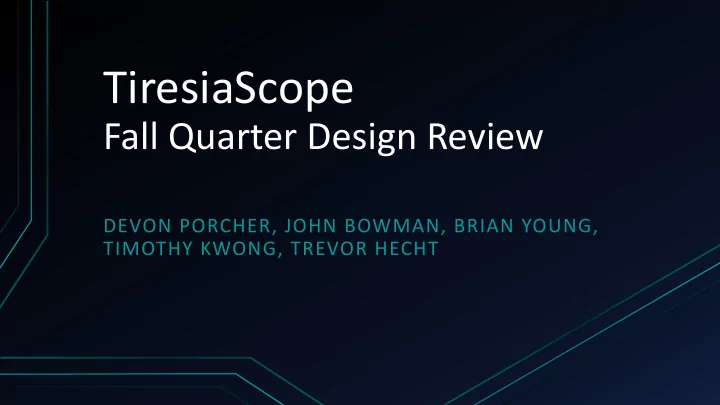

TiresiaScope Fall Quarter Design Review DEVON PORCHER, JOHN BOWMAN, BRIAN YOUNG, TIMOTHY KWONG, TREVOR HECHT
Introduction - What is the TiresiaScope? • A proximity-sensing device for the blind • Detects nearby objects with ranging sensors, recognizes text on signs with camera • Relays information to user through sound: musical tones for object location, synthesized speech for text reading
Development Team • Devon Porcher: Team Leader, Prototyping, Software Design • John Bowman: System Design Lead, Software Design • Brian Young: PCB Design Lead, System Design • Timothy Kwong: Software Design Lead • Trevor Hecht: Apparatus Design Lead
PYNQ • Dual-Cortex ARM Cortex A9 processor supports coding in Python • Individual Microblaze processors on FPGA control I/O for arduino and PMOD headers • Microblazes communicate with processor using shared memory • HDMI, USB, Ethernet also supported • Audio out is mono only
Camera: OpenMV M7 • On board STM32F765VI ARM Cortex M7 processor running at 216MHz with 512KB of RAM and 2MB of flash • The OV7725 image sensor is capable of taking 640x480 8-bit grayscale images or 320x240 16-bit RGB565 images at 30 FPS
Ultrasonic Sensor: Ultrasonic Range Finder - LV-MaxSonar-EZ1 • Detection range: 160mm to 6.45m • 20-Hz refresh rate • Reliable and stable range data • Pulse-Width, Analog, Pseudo-UART Interface options • Operates at 5V
Optical Sensor: Simblee™ IoT 3D ToF Sensor Module • Detection range: 100 mm to 2 meters • 10-Hz refresh rate • Breakout Board for mounting • I2C interface • Operates at 3.3V
Audio Codec: PCM3060 • Stereo audio output (and input) • SPI or I2C control interface • I2S, left-justified or right-justified formats for audio interface • Used commonly in digital TVs
Block Diagram
Printed Circuit Board Schematic
Printed Circuit Board Routing
Software Python is used for the backend processing Sensors • Converts sensor value inputs into noise frequency outputs of a certain tone depending on the range • Uses multithreading in order to have each sensor read and output values independently Camera • Will capture images caught into words and output using text-to-speech
Wearable Apparatus Current plan: • Skateboard helmet, with sections removed to make space for mounting Mounting: • PYNQ set into top of the helmet • Camera at front • Sensors distributed around all sides
Critical Elements Text Recognition with the OpenMV camera • Has on-board facial recognition, but not text recognition Reliability of sensors • Detecting lower objects • Lighting for reliable images
Bill of Materials
Conclusion Moving Forwards: • Prototyping full sensor system • Camera functionality • Designing software to function with the sound system Thank you to professor Yogananda Isukapalli, Celeste Bean, and Caio Motta Questions?
Recommend
More recommend